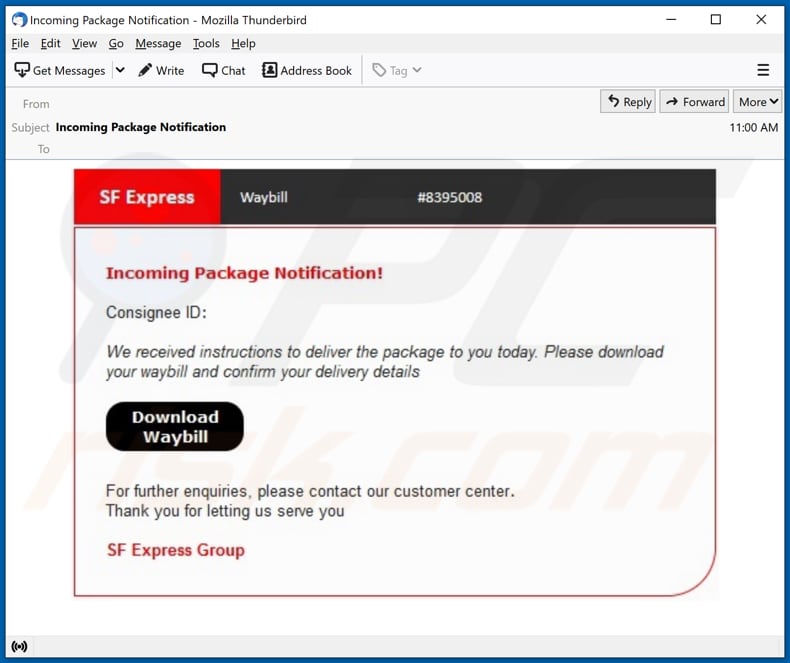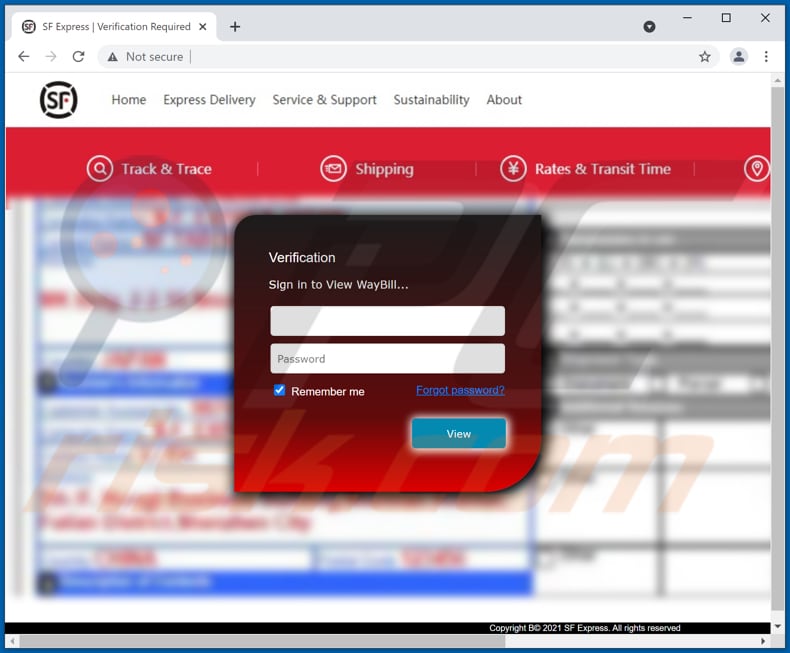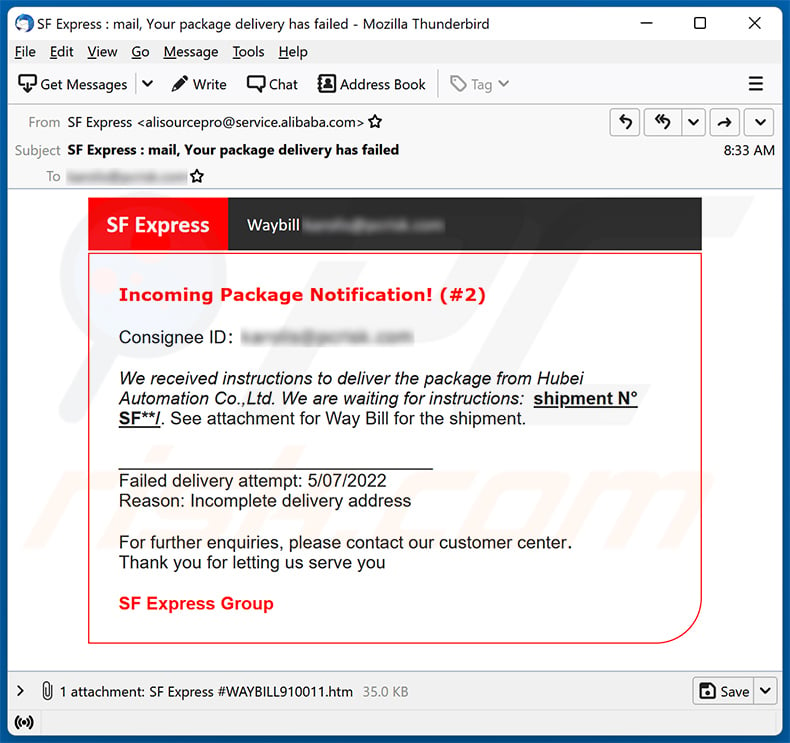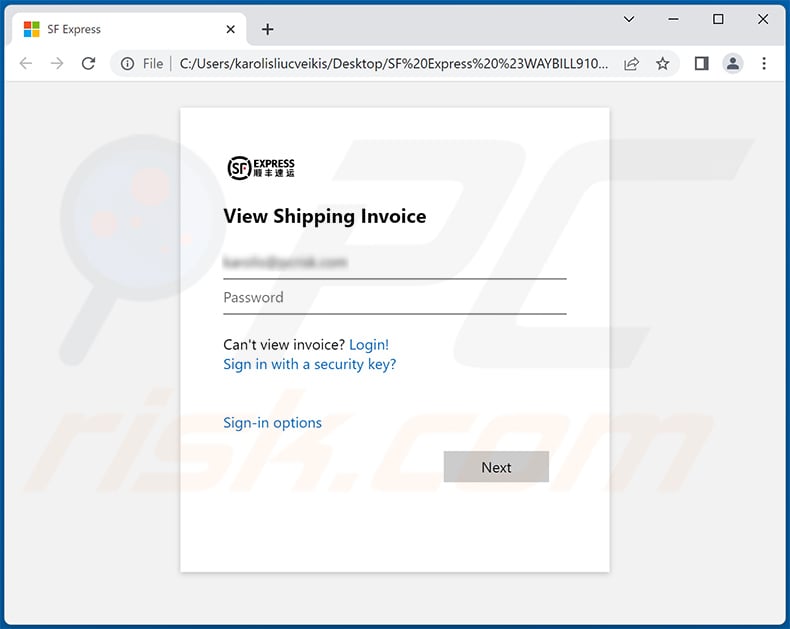How to recognize email scams like the SF Express email scam?
Phishing/ScamAlso Known As: SF Express spam
Get free scan and check if your device is infected.
Remove it nowTo use full-featured product, you have to purchase a license for Combo Cleaner. Seven days free trial available. Combo Cleaner is owned and operated by RCS LT, the parent company of PCRisk.com.
What is SF Express email scam?
The purpose of this email scam is to trick recipients into providing login credentials on a fake SF Express website. It is disguised as a letter regarding an incoming package. SF Express is a legitimate Chinese multinational delivery services and logistics company that has nothing to do with this phishing email.

Scammers behind this phishing email attempt to trick recipients into clicking on a link which is supposed to open a download website for a waybill (a document that contains details of the shipment). That link opens a fake SF Express website asking to sign in using an email address and password.
Scammers could use the provided login credentials to access email, social media, banking, or other accounts. Usually, scammers attempt to steal accounts that could be used to make fraudulent purchases, transactions, steal identities, deliver malicious software, and other purposes.
| Name | SF Express Email Scam |
| Threat Type | Phishing, Scam, Social Engineering, Fraud |
| Fake Claim | Email contains a download page for a waybill |
| Disguise | Letter from the SF Express company |
| Related Domain | news.rosfines[.]ru |
| Detection Names | Abusix (Spam), Emsisoft (Phishing), Fortinet (Phishing), Full List Of Detections (VirusTotal) |
| Symptoms | Unauthorized online purchases, changed online account passwords, identity theft, illegal access of the computer. |
| Distribution methods | Deceptive emails, rogue online pop-up ads, search engine poisoning techniques, misspelled domains. |
| Damage | Loss of sensitive private information, monetary loss, identity theft. |
| Malware Removal (Windows) |
To eliminate possible malware infections, scan your computer with legitimate antivirus software. Our security researchers recommend using Combo Cleaner. Download Combo CleanerTo use full-featured product, you have to purchase a license for Combo Cleaner. 7 days free trial available. Combo Cleaner is owned and operated by RCS LT, the parent company of PCRisk.com. |
Scammers use phishing emails to trick recipients into providing usernames, email addresses, passwords or other login credentials, credit card details, bank account numbers, or other information. More examples of similar emails are "Australia Post Email Scam" and "Aramex Email Scam". Cybercriminals can also use email to deliver malware.
How do spam campaigns infect computers?
Users install malware via emails by opening malicious attachments or files downloaded via provided links. Cybercriminals can use Microsoft Office documents, executable files, PDF documents, JavaScript files, and other types of files to deliver malware via emails.
Malicious documents opened with Microsoft Office 2010 and newer versions ask for permission to enable macros commands (editing). They cannot install malware while macros commands are disabled. Older MS Office versions cannot prevent malicious documents from installing malware because they do not have the "Protected View" mode.
How to avoid installation of malware?
Download files and programs only from official, trustworthy websites via direct links. Do not open email attachments (or website links) in irrelevant emails sent from unknown, suspicious addresses. Update and activate installed software with tools or functions provided by its official developer.
Scan the operating system for threats with a reputable antivirus or anti-spyware software and do it regularly. If you've already opened malicious attachments, we recommend running a scan with Combo Cleaner Antivirus for Windows to automatically eliminate infiltrated malware.
Text presented in the SF Express email scam:
Subject: Incoming Package Notification
SF Express Waybill #8395008
Incoming Package Notification!
Consignee ID:
We received instructions to deliver the package to you today. Please download your waybill and confirm your delivery details
Download Waybill
For further enquiries, please contact our customer center.
Thank you for letting us serve youSF Express Group
Fake SF Express website asking to provide login credentials:

Another example of SF Express-themed spam email distributing an HTML file used for phishing purposes:

Text presented within:
Subject: SF Express : mail, Yоսr расkаgе dеlivеry hаs fаilеd
SF Express
Waybill -
Incoming Package Notification! (#2)Consignee ID: -
We received instructions to deliver the package from Hubei Automation Co.,Ltd. We are waiting for instructions: shipment N° SF**/. See attachment for Way Bill for the shipment.
______________________________
Failed delivery attempt: 5/07/2022
Reason: Incomplete delivery addressFor further enquiries, please contact our customer center.
Thank you for letting us serve youSF Express Group
Screenshot of the distributed HTML attachment:

Instant automatic malware removal:
Manual threat removal might be a lengthy and complicated process that requires advanced IT skills. Combo Cleaner is a professional automatic malware removal tool that is recommended to get rid of malware. Download it by clicking the button below:
DOWNLOAD Combo CleanerBy downloading any software listed on this website you agree to our Privacy Policy and Terms of Use. To use full-featured product, you have to purchase a license for Combo Cleaner. 7 days free trial available. Combo Cleaner is owned and operated by RCS LT, the parent company of PCRisk.com.
Quick menu:
- What is SF Express spam?
- Types of malicious emails.
- How to spot a malicious email?
- What to do if you fell for an email scam?
Types of malicious emails:
![]() Phishing Emails
Phishing Emails
Most commonly, cybercriminals use deceptive emails to trick Internet users into giving away their sensitive private information, for example, login information for various online services, email accounts, or online banking information.
Such attacks are called phishing. In a phishing attack, cybercriminals usually send an email message with some popular service logo (for example, Microsoft, DHL, Amazon, Netflix), create urgency (wrong shipping address, expired password, etc.), and place a link which they hope their potential victims will click on.
After clicking the link presented in such email message, victims are redirected to a fake website that looks identical or extremely similar to the original one. Victims are then asked to enter their password, credit card details, or some other information that gets stolen by cybercriminals.
![]() Emails with Malicious Attachments
Emails with Malicious Attachments
Another popular attack vector is email spam with malicious attachments that infect users' computers with malware. Malicious attachments usually carry trojans that are capable of stealing passwords, banking information, and other sensitive information.
In such attacks, cybercriminals' main goal is to trick their potential victims into opening an infected email attachment. To achieve this goal, email messages usually talk about recently received invoices, faxes, or voice messages.
If a potential victim falls for the lure and opens the attachment, their computers get infected, and cybercriminals can collect a lot of sensitive information.
While it's a more complicated method to steal personal information (spam filters and antivirus programs usually detect such attempts), if successful, cybercriminals can get a much wider array of data and can collect information for a long period of time.
![]() Sextortion Emails
Sextortion Emails
This is a type of phishing. In this case, users receive an email claiming that a cybercriminal could access the webcam of the potential victim and has a video recording of one's masturbation.
To get rid of the video, victims are asked to pay a ransom (usually using Bitcoin or another cryptocurrency). Nevertheless, all of these claims are false - users who receive such emails should ignore and delete them.
How to spot a malicious email?
While cyber criminals try to make their lure emails look trustworthy, here are some things that you should look for when trying to spot a phishing email:
- Check the sender's ("from") email address: Hover your mouse over the "from" address and check if it's legitimate. For example, if you received an email from Microsoft, be sure to check if the email address is @microsoft.com and not something suspicious like @m1crosoft.com, @microsfot.com, @account-security-noreply.com, etc.
- Check for generic greetings: If the greeting in the email is "Dear user", "Dear @youremail.com", "Dear valued customer", this should raise suspiciousness. Most commonly, companies call you by your name. Lack of this information could signal a phishing attempt.
- Check the links in the email: Hover your mouse over the link presented in the email, if the link that appears seems suspicious, don't click it. For example, if you received an email from Microsoft and the link in the email shows that it will go to firebasestorage.googleapis.com/v0... you shouldn't trust it. It's best not to click any links in the emails but to visit the company website that sent you the email in the first place.
- Don't blindly trust email attachments: Most commonly, legitimate companies will ask you to log in to their website and to view any documents there; if you received an email with an attachment, it's a good idea to scan it with an antivirus application. Infected email attachments are a common attack vector used by cybercriminals.
To minimise the risk of opening phishing and malicious emails we recommend using Combo Cleaner Antivirus for Windows.
Example of a spam email:

What to do if you fell for an email scam?
- If you clicked on a link in a phishing email and entered your password - be sure to change your password as soon as possible. Usually, cybercriminals collect stolen credentials and then sell them to other groups that use them for malicious purposes. If you change your password in a timely manner, there's a chance that criminals won't have enough time to do any damage.
- If you entered your credit card information - contact your bank as soon as possible and explain the situation. There's a good chance that you will need to cancel your compromised credit card and get a new one.
- If you see any signs of identity theft - you should immediately contact the Federal Trade Commission. This institution will collect information about your situation and create a personal recovery plan.
- If you opened a malicious attachment - your computer is probably infected, you should scan it with a reputable antivirus application. For this purpose, we recommend using Combo Cleaner Antivirus for Windows.
- Help other Internet users - report phishing emails to Anti-Phishing Working Group, FBI’s Internet Crime Complaint Center, National Fraud Information Center and U.S. Department of Justice.
Frequently Asked Questions (FAQ)
Why did I receive this email?
Most scammers send the exact same email to thousands of people hoping that someone will fall for it. These emails are never personal. The same applies to this phishing email that looks like a letter from a company called SF Express.
I have provided my personal information when tricked by this email, what should I do?
If you have entered login credentials on a fake SF Express website, change all passwords immediately. If you have provided other personal information (such as credit card details, ID card information, etc.), contact corresponding authorities as soon as possible.
Can Combo Cleaner remove malware that cybercriminals spread via email?
Yes, Combo Cleaner is capable of detecting and eliminating almost all known malware infections. It is recommended to run full system scan since most high-end malicious programs hide deep in the system.
Share:

Tomas Meskauskas
Expert security researcher, professional malware analyst
I am passionate about computer security and technology. I have an experience of over 10 years working in various companies related to computer technical issue solving and Internet security. I have been working as an author and editor for pcrisk.com since 2010. Follow me on Twitter and LinkedIn to stay informed about the latest online security threats.
PCrisk security portal is brought by a company RCS LT.
Joined forces of security researchers help educate computer users about the latest online security threats. More information about the company RCS LT.
Our malware removal guides are free. However, if you want to support us you can send us a donation.
DonatePCrisk security portal is brought by a company RCS LT.
Joined forces of security researchers help educate computer users about the latest online security threats. More information about the company RCS LT.
Our malware removal guides are free. However, if you want to support us you can send us a donation.
Donate
▼ Show Discussion